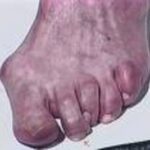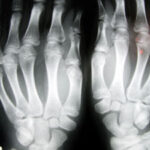Hallux rigidus is a form of degenerative arthritis that occurs in the joint at the base of the big toe. People who have fallen arches or excessive pronation (rolling) of the ankle are more likely to develop hallux rigidus. It most commonly affects people between the ages of 30 and 60, and can be inherited from family members with biomechanical abnormalities.
Workers who have to stoop and squat put increased stress on the toes and this can lead to hallux rigidus. Something as simple as just stubbing your toe could also cause this condition.
Inflammatory conditions such as rheumatoid arthritis and gout can also cause hallux rigidus.
Early signs and symptoms of hallux rigidus may include swelling and inflammation around the joint. You may notice pain and stiffness in your big toe when you walk or stand. You may also have difficulty running, squatting or bending.
As the condition progresses, the toe’s motion decreases until the big toe becomes stiff. This condition is known as a “frozen joint.” You may have constant pain in the toe joint, even when resting. Since it’s too painful to exercise, you may gain weight. Other parts of your foot may be painful since you’re shifting your weight off the big toe. Knees, hips, and your lower back may hurt due to changes in your walking gait, and you may start limping.
Your doctor can sometimes diagnose hallux rigidus just by looking at your foot. Laboratory tests will be ordered to rule out or confirm the presence of gout or rheumatoid arthritis. An x-ray is usually required to determine the extent of the degeneration in the toe.
There are non-surgical options that your doctor may want to try. These include:
Padding your foot with a bunion guard
Orthotic inserts in your shoes
Wearing stiff-soled shoes with a wide toe box
Calf stretching exercises
Ice
Cortisone shot
Taking ibuprofen as an anti-inflammatory
Taking glucosamine sulfate or chondroitin sulfate
Having a shoe repair shop stretch your shoes
You will notice an improvement in some of your symptoms within a few days. The ibuprofen may take 7-10 days to reach its full effect. The cortisone shot should relieve your symptoms within 24 hours.
If all else fails, surgery may be needed. There are several types of procedures including:
Cheilectomy- This procedure removes the bone spurs at the top of the joint so they don’t bump together when you extend your toe. Your toe will bend better and you won’t have as much pain walking.
Joint Fusion- A joint fusion is favored by many surgeons to relieve pain. An incision is made into the MTP joint and the joint surfaces are removed. These two surfaces are fixed with a metal screw or pin. The toe is turned slightly upward for walking. It usually takes about three months for the fusion to become solid.
Artificial Joint Replacement- Favored by some surgeons, it is the same operation done to a knee or hip, only on a smaller scale. The surgeon makes an incision over the MTP joint. The arthritic surface of the proximal phalanx is removed. Different size implants are used to ensure a snug fit, and the surgeon moves the toe through a range of motions. When he is satisfied that everything fits, he implants the artificial joint.
After surgery you may be fitted with a wooden soled shoe or cast to protect the bones, and you may have to use crutches temporarily. Your doctor may also order physical therapy. If you had stitches, they can usually be removed in 10-14 days.
You should rest completely for four days and take your prescribed pain killers. After two weeks, the doctor will re-dress your foot and you can gently increase activity, but don’t overdo it.
In 2-6 weeks, you can wear shoes again, and return to work on light duty. Your foot will still be swollen at the end of the day. You can resume normal activities, but no sports.




